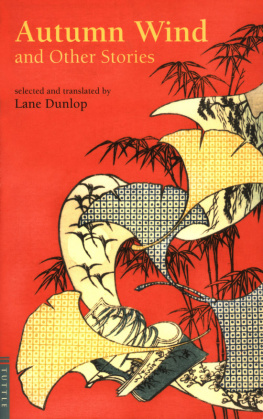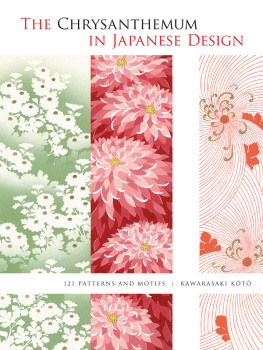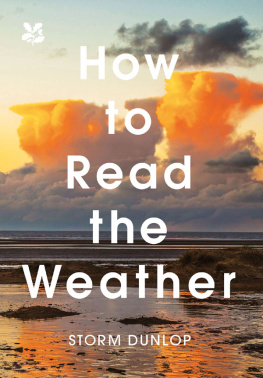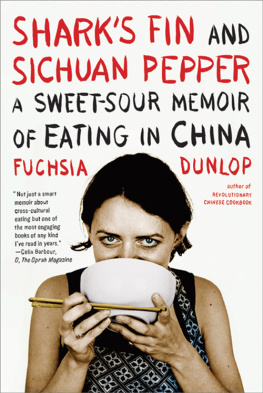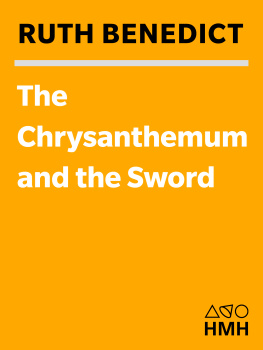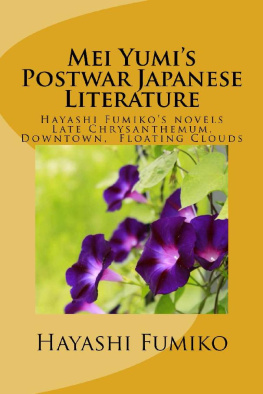Lane Dunlop - A Late Chrysanthemum: Twenty-one Stories from the Japanese
Here you can read online Lane Dunlop - A Late Chrysanthemum: Twenty-one Stories from the Japanese full text of the book (entire story) in english for free. Download pdf and epub, get meaning, cover and reviews about this ebook. year: 1988, publisher: Charles E. Tuttle Company, genre: Detective and thriller. Description of the work, (preface) as well as reviews are available. Best literature library LitArk.com created for fans of good reading and offers a wide selection of genres:
Romance novel
Science fiction
Adventure
Detective
Science
History
Home and family
Prose
Art
Politics
Computer
Non-fiction
Religion
Business
Children
Humor
Choose a favorite category and find really read worthwhile books. Enjoy immersion in the world of imagination, feel the emotions of the characters or learn something new for yourself, make an fascinating discovery.
- Book:A Late Chrysanthemum: Twenty-one Stories from the Japanese
- Author:
- Publisher:Charles E. Tuttle Company
- Genre:
- Year:1988
- Rating:4 / 5
- Favourites:Add to favourites
- Your mark:
- 80
- 1
- 2
- 3
- 4
- 5
A Late Chrysanthemum: Twenty-one Stories from the Japanese: summary, description and annotation
We offer to read an annotation, description, summary or preface (depends on what the author of the book "A Late Chrysanthemum: Twenty-one Stories from the Japanese" wrote himself). If you haven't found the necessary information about the book — write in the comments, we will try to find it.
A Late Chrysanthemum: Twenty-one Stories from the Japanese — read online for free the complete book (whole text) full work
Below is the text of the book, divided by pages. System saving the place of the last page read, allows you to conveniently read the book "A Late Chrysanthemum: Twenty-one Stories from the Japanese" online for free, without having to search again every time where you left off. Put a bookmark, and you can go to the page where you finished reading at any time.
Font size:
Interval:
Bookmark:
A Late
Chrysanthemum
The first half of this century saw the coming of age of the Japanese short story. Influenced by Western literary techniques, such innovative writers as Shiga Naoya, Ozaki Shiro, Yasunari Kawabata, Shimaki Kensaku, Hayashi Fumiko, Dazai Osamu, and (somewhat later) Kobo Abe reassessed the Japanese story tradition and brought new vigor to the uniquely Japanese sense of the detail and natural context of everyday life.
The works of these writers stand at the center of modern Japans literary development. Despite their differences, it is the simplicity and purity of their natural imagessultry late-summer days, cicadas, lizards, and the sounds of lifes routinesthat more than anything anchor the emotions and perceptions of their stories.
For A Late Chrysanthemum , translator and editor Lane Dunlop has selected twenty-one stories by these seven intriguing and influential authors to convey the depth and range of the modern Japanese story, a discriminating selection which, in Dunlops sure and masterful English renderings, won this book the Japan-United States Friendship Award for Literary Translation.
A Late
Chrysanthemum

Twenty-one
Stories from the Japanese

TRANSLATED BY
Lane Dunlop

CHARLES E. TUTTLE COMPANY
Tokyo, Japan
Published by the Charles E. Tuttle Company, Inc.
of Rutland, Vermont & Tokyo, Japan
with editorial offices at
Osaki Shinagawa-ku, Tokyo 141-0032
by special arrangement with North Point Press, Berkeley, California
Grateful acknowledgment is extended to the authors estates for granting permission to publish these English translations: Akagaeru, Mukade, Kuroneko, and Jigabachi by Shimaki Kensaku copyright Kyo Asakura, originally published in Japan, all rights reserved; Kajika and Sekirei no Su by Ozaki Shiro copyright Kiyoko Ozaki, September 1927, originally published in Japan, all rights reserved; Kinosaki nite, Kamisori, Chijo, and Hai iro no Tsuki by Shiga Naoya copyright Shiga Naokichi, October 1917, originally published in Japan, all rights reserved; Bangiku by Hayashi Fumiko copyright Ryokubin Hayashi, November 1948, originally published in Japan, all rights reserved; Omoide, Chiyojo, Ogon Fukei, and Toro by Dazai Osamu copyright Michiko Tsushima, March 1933, originally published in Japan, all rights reserved; Suruga no Reijo, Gumi Nusutto, and Batta to Suzumu-shi by Kawabata Yasunari copyright Mrs. Hideko Kawabata, originally published in Japan, all rights reserved; Akai Mayu, Kozui, and Bo by Ab Kobo copyright Abe Kobo, originally published in Japan, all rights reserved.
Translation and Translators Notes copyright 1986 by Lane Dunlop First published in the English language by North Point Press
All rights reserved
First Tuttle edition, 1988
Second printing, 1991
ISBN 0-8048-1578-X; 978-1-4629-1811-9 (ebook)
Printed in Japan
Contents
Translators Preface
The seven writers in this selection are significant writers, represented by some of their best-known work. Shiga Naoya, for instance, is known as the god of the short story for his dominant influence in the genre, and the two stories by the major novelist Ozaki Shiro are thought to be among his very best. And of how many writers can it be said, as of Dazai Osamu, that their graves are decorated every year on their death anniversaries by schoolgirls in a spontaneous outpouring of respectful affection? Kawabata of course needs no introduction, and the four stories of Shimaki Kensaku in this book, all written while he was in bed with his final illness, are regarded as the enduring kernel of his work.
Most of the stories are from what is generally agreed to be the golden age of twentieth-century Japanese literature, the entre deux guerres period from the close of the Russo-Japanese War (1905) to the onset of World War II, or The Pacific War as its called in Japan. During this period, a necessary freshening Western influence was kept nicely in balance with what was unique to Japan. Western form was given Japanese content: the details of everyday living peculiar to Japan then, a feeling for Nature and a disposition to look there for clues as to how to live ones life, and a belief in purity and simplicity of feeling as their own justification. I would call particular attention to the awareness of Nature in many of these stories. Time and again, it is the natural detail that serves to set an experience in memory. The dusky room on the bank of the Edogawa, the sultry late-summer day, came back to her. She could hear the steady, clunking sound of the automatic irrigation pump, the cicadas ascending cry. This is the memory of a love affair in Hayashi Fumikos A Late Chrysanthemum. Such awareness of Natures presence, sometimes as unobtrusive as a phrase about the way the light looks at a certain hour, amounts to a saving grace.
These qualities, alas, have largely been lost in the postwar period. In the work of Kobo Abe, we emerge into the thoroughly alienated, urban-centered consciousness of international modern writing. Yet even so, in the Kafka-esque transmogrifications of his hapless characters, there is a sort of gentleness and vestigial love of Nature: they turn, not into gigantic cockroaches, but into a red cocoon, a stick, and a sort of water.
LANE DUNLOP
Acknowledgments
Acknowledgments are due to the editors of the following magazines, in which these stories first appeared in slightly different form: Prairie Schooner for Infatuation, A Gray Moon, At Kinosaki, The Grasshopper and the Bell Cricket, The Silverberry Thief, The Young Lady of Suruga, and The Red Frog; New England Review/Bread Loaf Quarterly for The Razor and River Deer; Translation for The Wagtails Nest and A Late Chrysanthemum; Antaeus for The Centipede; Stand for The Black Cat; The Missouri Review for The Wasps; Mississippi Review for Memories, A Golden Picture, and The Garden Lantern; Michigan Quarterly Review for Chiyojo; TriQuarterly for The Red Cocoon, The Flood, and The Stick.
A Late
Chrysanthemum
SHIGA NAOYA
[1883-1971]
Infatuation
It was a cold, thinly overcast day. With a slight headache from the chill and feeling much depressed, hed shut himself up in his study. From time to time snow had been falling, hiding the mountains beyond. There was a pond in the garden, and the snow would quickly fall and disappear in it. As he looked through the panes of the shoji and the glass outer door, the snow stopped and blue sky appeared. It was typical mountain weather.
He could not make up his mind what to do in this affair. It would be best to give up the woman, but he disliked that idea as having come from his wife. The woman herself felt no affection for him. If he came to feel nothing for her and they quietly separated, well and good. But he could not steel himself to the forced obedience of leaving her now, although for a while he had meant to. Nevertheless it was disagreeable to go on deceiving his wife, who for her part had been magnanimous in the affair. If he added this to all the previous considerations, it was clearly an impossible situation. It would have been ideal, of course, had it been possible for him. He had even gone so far as to suggest the possibility the night before, but had immediately realized that it was a hopeless venture.
His wife had asked him to settle the affair today. She was in earnest. He could not compete with her sincerity. He had thought that he was being unusually serious himself but was far behind his wife in this respect.
Next pageFont size:
Interval:
Bookmark:
Similar books «A Late Chrysanthemum: Twenty-one Stories from the Japanese»
Look at similar books to A Late Chrysanthemum: Twenty-one Stories from the Japanese. We have selected literature similar in name and meaning in the hope of providing readers with more options to find new, interesting, not yet read works.
Discussion, reviews of the book A Late Chrysanthemum: Twenty-one Stories from the Japanese and just readers' own opinions. Leave your comments, write what you think about the work, its meaning or the main characters. Specify what exactly you liked and what you didn't like, and why you think so.


